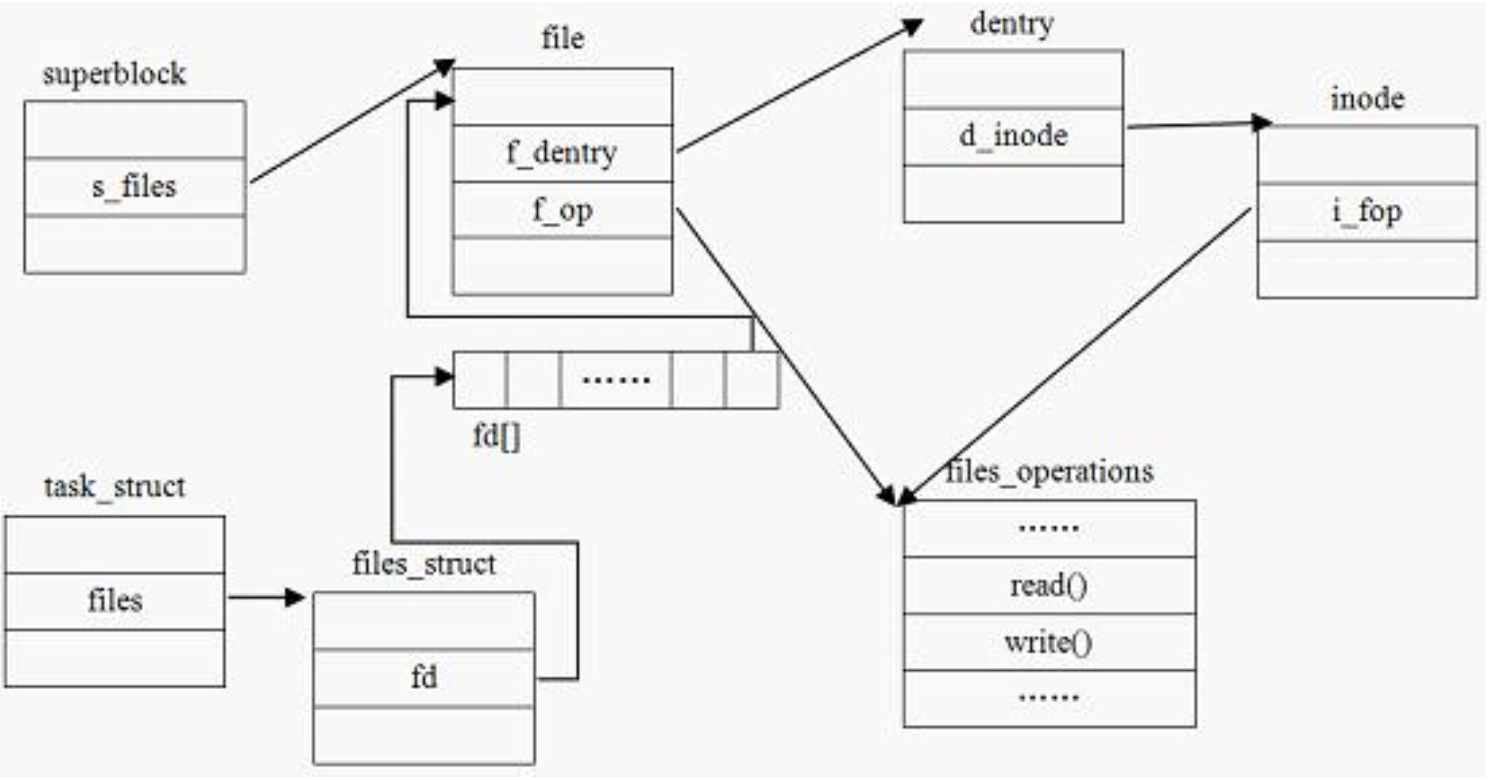vfs:结构体对象
VFS结构体
super_block
存储一个已安装的文件系统的控制信息,代表一个已安装的文件系统;每次一个实际的文件系统被安装时, 内核会从磁盘的特定位置读取一些控制信息来填充内存中的超级块对象。一个安装实例和一个超级块对象一一对应。 超级块通过其结构中的一个域s_type记录它所属的文件系统类型。
struct super_block { //超级块数据结构
struct list_head s_list; /*指向超级块链表的指针*/
……
struct file_system_type *s_type; /*文件系统类型*/
struct super_operations *s_op; /*超级块方法*/
……
struct list_head s_instances; /*该类型文件系统*/
……
};
struct super_operations { //超级块方法
……
//该函数在给定的超级块下创建并初始化一个新的索引节点对象
struct inode *(*alloc_inode)(struct super_block *sb);
……
//该函数从磁盘上读取索引节点,并动态填充内存中对应的索引节点对象的剩余部分
void (*read_inode) (struct inode *);
……
};
inode
索引节点对象存储了文件的相关信息,代表了存储设备上的一个实际的物理文件。当一个 文件首次被访问时,内核会在内存中组装相应的索引节点对象,以便向内核提供对一个文件进行操 作时所必需的全部信息;这些信息一部分存储在磁盘特定位置,另外一部分是在加载时动态填充的。
struct inode {//索引节点结构
……
struct inode_operations *i_op; /*索引节点操作表*/
struct file_operations *i_fop; /*该索引节点对应文件的文件操作集*/
struct super_block *i_sb; /*相关的超级块*/
……
};
struct inode_operations { //索引节点方法
……
//该函数为dentry对象所对应的文件创建一个新的索引节点,主要是由open()系统调用来调用
int (*create) (struct inode *,struct dentry *,int, struct nameidata *);
//在特定目录中寻找dentry对象所对应的索引节点
struct dentry * (*lookup) (struct inode *,struct dentry *, struct nameidata *);
……
};
dentry
引入目录项的概念主要是出于方便查找文件的目的。一个路径的各个组成部分,不管是目录还是 普通的文件,都是一个目录项对象。如,在路径/home/source/test.c中,目录 /, home, source和文件 test.c都对应一个目录项对象。不同于前面的两个对象,目录项对象没有对应的磁盘数据结构,VFS在遍 历路径名的过程中现场将它们逐个地解析成目录项对象。
struct dentry {//目录项结构
……
struct inode *d_inode; /*相关的索引节点*/
struct dentry *d_parent; /*父目录的目录项对象*/
struct qstr d_name; /*目录项的名字*/
……
struct list_head d_subdirs; /*子目录*/
……
struct dentry_operations *d_op; /*目录项操作表*/
struct super_block *d_sb; /*文件超级块*/
……
};
struct dentry_operations {
int (*d_revalidate)(struct dentry *, unsigned int); //判断目录项是否有效;
int (*d_weak_revalidate)(struct dentry *, unsigned int);
int (*d_hash)(const struct dentry *, struct qstr *); //为目录项生成散列值;
int (*d_compare)(const struct dentry *, const struct dentry *,
unsigned int, const char *, const struct qstr *);
int (*d_delete)(const struct dentry *);
void (*d_release)(struct dentry *);
void (*d_prune)(struct dentry *);
void (*d_iput)(struct dentry *, struct inode *);
char *(*d_dname)(struct dentry *, char *, int);
struct vfsmount *(*d_automount)(struct path *);
int (*d_manage)(struct dentry *, bool);
} ____cacheline_aligned;
file
文件对象是已打开的文件在内存中的表示,主要用于建立进程和磁盘上的文件的对应关系。它由sys_open() 现场创建,由sys_close()销毁。文件对象和物理文件的关系有点像进程和程序的关系一样。当我们站在用户空间来看 待VFS,我们像是只需与文件对象打交道,而无须关心超级块,索引节点或目录项。因为多个进程可以同时打开和操作 同一个文件,所以同一个文件也可能存在多个对应的文件对象。文件对象仅仅在进程观点上代表已经打开的文件,它 反过来指向目录项对象(反过来指向索引节点)。一个文件对应的文件对象可能不是惟一的,但是其对应的索引节点和 目录项对象无疑是惟一的。
struct file {
……
struct list_head f_list; /*文件对象链表*/
struct dentry *f_dentry; /*相关目录项对象*/
struct vfsmount *f_vfsmnt; /*相关的安装文件系统*/
struct file_operations *f_op; /*文件操作表*/
……
};
struct file_operations {
……
//文件读操作
ssize_t (*read) (struct file *, char __user *, size_t, loff_t *);
……
//文件写操作
ssize_t (*write) (struct file *, const char __user *, size_t, loff_t *);
……
int (*readdir) (struct file *, void *, filldir_t);
……
//文件打开操作
int (*open) (struct inode *, struct file *);
……
};
进程与超级块、文件、索引结点、目录项的关系

nameidata路径查找辅助结构
struct path {
struct vfsmount *mnt;
struct dentry *dentry;
};
/*
* "quick string" -- eases parameter passing, but more importantly
* saves "metadata" about the string (ie length and the hash).
*
* hash comes first so it snuggles against d_parent in the
* dentry.
*/
struct qstr {
union {
struct {
HASH_LEN_DECLARE;
};
u64 hash_len;
};
const unsigned char *name;
};
struct nameidata {
struct path path;
struct qstr last;
struct path root;
struct inode *inode; /* path.dentry.d_inode */
unsigned int flags;
unsigned seq;
int last_type;
unsigned depth;
char *saved_names[MAX_NESTED_LINKS + 1];
};
open.c
kernel-3-10
@do_sys_open
@get_unused_fd_flags
@do_filp_open
1.开始填充nameidata
2.开始填充file
@path_openat
1. file = get_empty_filp(); //开始填充file
2. file->f_flags = op->open_flag; //开始填充file
3. path_init(dfd, pathname->name, flags | LOOKUP_PARENT, nd, &base);
//开始填充初始化nameidata,并且从根查找
3.1 nd->last_type = LAST_ROOT;
3.2 nd->flags = flags | LOOKUP_JUMPED;
3.3 nd->depth = 0;
3.4 nd->path = nd->root;
3.5 nd->inode = inode;
4. link_path_walk(pathname->name, nd);
5. do_last(nd, &path, file, op, &opened, pathname);
// 某些条件下会进入:
5.1 fput(file): //释放file
5.2 dput(path->dentry); // 释放dentry
@get_unused_fd: 得到一个可用的文件描述符;通过该函数,可知文件描述符实质是进程打开文件列表中对应某个文件对象的索引值;
@do_filp_open: do_filp_open()打开文件,返回一个file对象,代表由该进程打开的一个文件;进程通过这样的一个数据结构对物理文件进行读写操作。
@path_openat:返回一个file对象,@do_filp_open 直接把活扔给@path_openat. filp = path_openat(dfd, pathname, &nd, op, flags | LOOKUP_RCU)
muahao@aliyun.com


